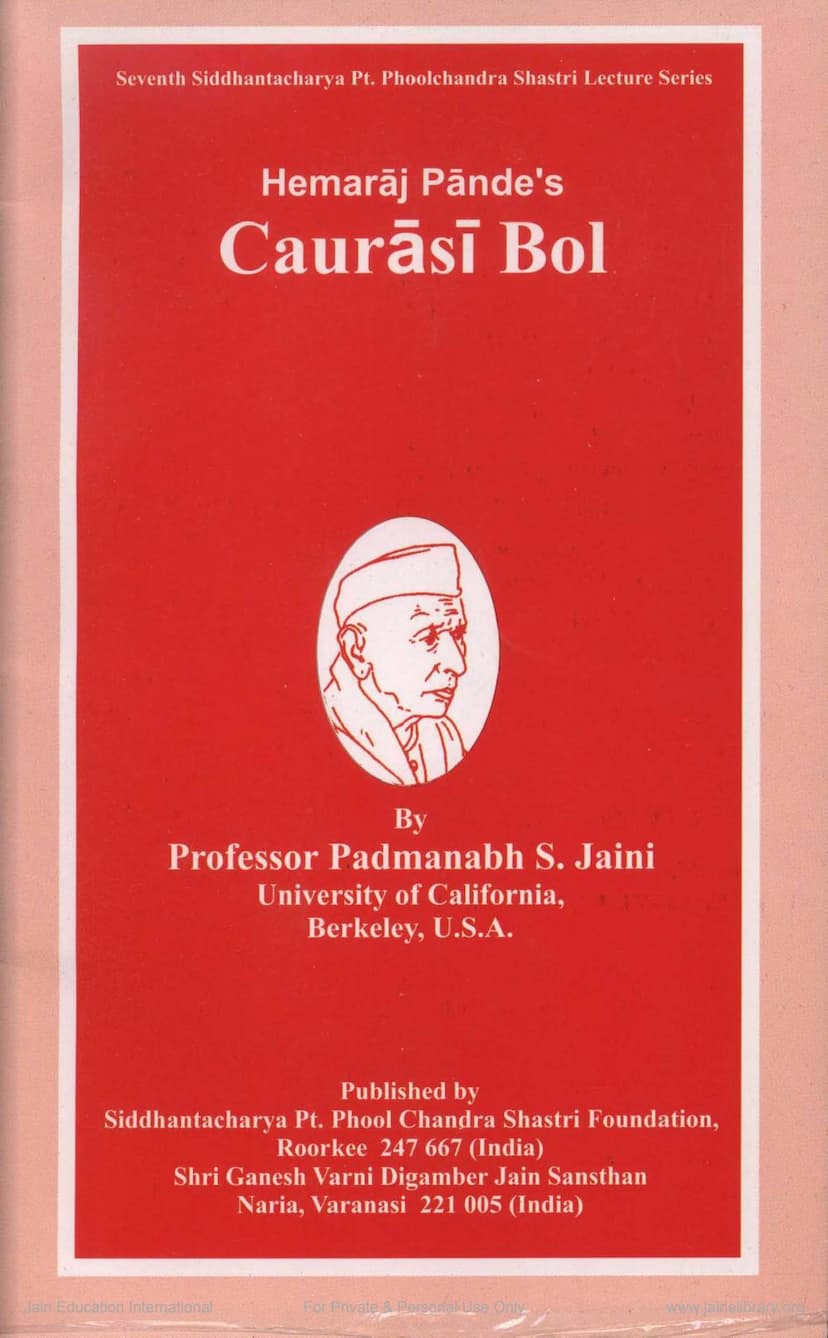Caurasi Bol
Added to library: September 1, 2025
Loading image...

Summary
This document is a publication of the Seventh Siddhantacharya Pt. Phoolchandra Shastri Lecture Series, featuring a lecture by Professor Padmanabh S. Jaini titled "Hemarāj Pānde's Caurāsī Bol."
Key aspects of the document include:
- Author and Lecturer: Professor Padmanabh S. Jaini, a renowned scholar from the University of California, Berkeley.
- Subject Matter: The lecture focuses on the "Caurāsī Bol" (Eighty-Four Points of Controversy) composed by Hemarāj Pānde.
- Publication Details: Published by the Siddhantacharya Pt. Phool Chandra Shastri Foundation, Roorkee, and Shri Ganesh Varni Digamber Jain Sansthan, Varanasi. The first edition was released in 2007 AD.
- Context of the Lecture: The lecture was delivered on October 20, 2004, at Jain Math, Shri Shravanbelgola, under the auspices of the National Institute of Prakrit Studies and Research, in the presence of H. H. Swastishri Charukeerti Bhattarak Mahaswamiji. This event coincided with the release of the English translation of Dhavala-Book One, also by Prof. P. S. Jaini.
- Professor Jaini's Connection to Pt. Phoolchandra Shastri: Professor Jaini expresses deep respect and personal connection to Pandit Phoolchandraji, highlighting his vast knowledge and enthusiastic sharing of Jain doctrines. He mentions how Panditji's works influenced his own research.
- Hemarāj Pānde's Caurāsī Bol:
- The text is identified as a refutation of the Shvetāmbara "Sitapata Caurāsī Bol" by Upādhyāya Yashovijayaji.
- Hemarāj Pānde's work is a metrical Hindi composition of ninety-one verses.
- The number "eighty-four" likely symbolizes the eighty-four hundred thousand varieties of yonis (life forms) a jīva can be reborn into, suggesting that those holding these Shvetambara views may not escape samsara.
- It is noted that this is likely the first Digambara work on this specific topic.
- Hemarāj Pānde is also known for his Hindi Bālāvabodha commentary on Acharya Kundakunda's Pravacanasāra, completed in 1653 AD.
- The Core of the Debate: The Caurāsī Bol addresses numerous points of contention between the Digambara and Shvetambara traditions. While kevali-bhukti (whether an omniscient being partakes of food) and strī-mukti (whether a woman can attain salvation in her current life) are major debates, Hemarāj's work covers many other doctrinal differences.
- List of 84 Points: The document provides a detailed outline of the 84 disputed views attributed by Hemarāj Pande to the Shvetāmbaras. These points cover a wide range of topics, including:
- The nature of the kevalin (omniscience, partaking of food, bodily functions, susceptibility to disease and suffering).
- The life and actions of Tirthankaras (attending school, distributing gifts, receiving divine clothing, initial sermons, conception and birth, marriage, family lineage).
- Specific instances from Jain mythology and history (e.g., Mahāvīra's conception, Adinātha's marriages, Gautama's interactions, Malli and Nemi's celibacy, Draupadi's marriage, Kapila's dance, Vasudeva's wives, Bahubali's height, ascetics' practices, the nature of kāla as a substance, the ganadhara of Munisuvrata, eating meat under special conditions, begging practices, responding to insults).
- Practices related to asceticism and vows (keeping requisites, nudity, taking medicine while fasting, receiving food from different castes).
- Views on liberation and spiritual attainment (householders attaining kevalajnāna, achieving moksha without renunciation, the possibility of a chandala becoming a muni).
- Temple worship and iconography (worshipping ornamented images, invisibility of a Jina's nudity, Indra's role).
- Celestial beings and their interactions with humans.
- Specific details about dreams, atishayas (special qualities of Tirthankaras), and the nature of heavenly abodes.
- The Shvetambara tradition's differing lists of defects and atishayas.
- The concept of acherā (miracle) in Shvetambara theology.
- The authenticity and existence of Jain Agamas.
- Comparison with Upādhyāya Yashovijayaji's Refutation: The document also includes a list of points addressed by Upādhyāya Yashovijayaji in his "Dikpata Caurāsī Bol [Pratyukti]," which served as a refutation of Hemarāj Pānde's work. This comparison highlights areas of agreement and disagreement, such as the eighteen defects of a kevalin, the nature of kevali's speech, and the practice of worship.
- Historical Context and Movement: The preface and notes provide historical context, mentioning the "Ādhyātmikashailī" or Spiritual Movement of the 16th and 17th centuries in North India, which influenced both Digambara and Shvetambara thinkers. The role of figures like Banarasidas and the resulting dissensions within the Shvetambara community are discussed, as well as the academic responses by Upādhyāya Yashovijaya and Upādhyāya Meghavijaya.
- Manuscript Details: The document mentions the discovery of a manuscript of Caurāsī Bol in Surat and another in Rajasthan, with Professor Jaini obtaining a xerox copy of the latter. The manuscript from Rajasthan is dated Samvat 1723 (1666 AD).
- Concluding Remarks: Hemarāj Pānde concludes his work by stating he did not write it out of sectarian spirit but from a desire for satya-artha (true meaning), aiming to illuminate hearts and increase knowledge.
In essence, "Hemarāj Pānde's Caurāsī Bol" is a significant Digambara polemical work that meticulously lists and critiques 84 doctrinal points held by the Shvetāmbaras. Professor Padmanabh S. Jaini's lecture and the accompanying publication offer a scholarly analysis of this important text, situating it within the broader history of sectarian debates in Jainism.